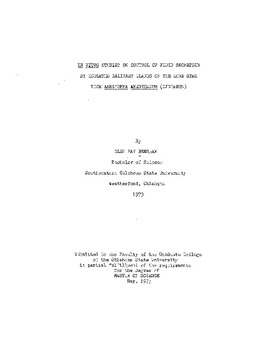| dc.contributor.advisor | Sauer, John R. | |
| dc.contributor.author | Needham, Glen Ray | |
| dc.date.accessioned | 2015-10-19T18:21:05Z | |
| dc.date.available | 2015-10-19T18:21:05Z | |
| dc.date.issued | 1975-05-01 | |
| dc.identifier.uri | https://hdl.handle.net/11244/20101 | |
| dc.description.abstract | This investigation was designed to use an in vitro technique to elucidate possible mechanisms of control of fluid secretion by salivary glands of the feeding female lone star tick, Amblyomma americanum (L.). Various drugs and/or inhibitors were incorporated into the bathing medium surroudning isolated glands with the effects on fluid secretion being determined by changes in the rate of fluid secreted. Potential stimulants used were cyclic AMP, theophylline, pilocarpine, glutamate, 5-hydroxytryptamine and noradrenaline; adrenaline served as a control for all experiments to determine secretory competence of glands. Ouabain, harmaline and 2,4-dinitrophenol were potential inhibitors incorporated into the bathing medium containing adrenaline, with results compared to a control in which adrenaline was present without the inhibitor. | |
| dc.format | application/pdf | |
| dc.language | en_US | |
| dc.publisher | Oklahoma State University | |
| dc.rights | Copyright is held by the author who has granted the Oklahoma State University Library the non-exclusive right to share this material in its institutional repository. Contact Digital Library Services at lib-dls@okstate.edu or 405-744-9161 for the permission policy on the use, reproduction or distribution of this material. | |
| dc.title | In Vitro Studies on Control of Fluid Secretion by Isolated Salivary Glands of the Lone Star Tick Amblyomma Americanum (Linnaeus) | |
| dc.type | text | |
| dc.contributor.committeeMember | Beames, Calvin G., Jr. | |
| dc.contributor.committeeMember | Hair, J. Alexander | |
| osu.filename | Thesis-1975-N374i.pdf | |
| osu.accesstype | Open Access | |
| dc.description.department | Entomology | |
| dc.type.genre | Thesis | |
